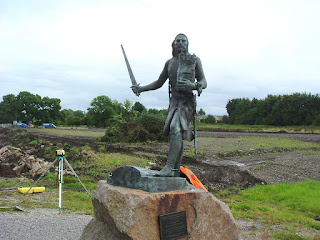This was to have been a walk as far as Lynmouth, but poor weather conditions during the second day dictated that I abandon the walk before completion.
Minehead to Silcombe Farm - 25 August - 12 MilesUnusually, this trip started late (for me) in order to take advantage of cheap advance rail fares with Cross-Country Trains. I caught the 0942 train from Birmingham New Street, arriving punctually at Taunton by 1200. There was a short wait at the station before the First Number 28 bus took me to Minehead via a number of villages en-route. I finally arrived at Minehead at 1340 and commenced my walk.
My first impressions of Minehead were the large tent-like structure to the right along the seafront and the wooded hill of Higher Town dotted with posh houses to the left. I turned left and climbed out of Minehead along a footpath, then a minor road and finally onto the Southwest Coast Path, which was well defined - more like a track. The track rose through woodland and onto moorland carpeted with heather. The walking was easy and the 4.5 miles to Selworthy Beacon was quickly reached at 1512.

Eventually, the path dropped steeply to the left of Hurlstone Point to meet the sea. The path turned left under Hurlstone Point and followed a tranquil stream into the village of Bossington (1605). Bossington is attractive, quiet and unspoilt. It has a variety of houses of different periods and styles and, in my opinion, is a much more pleasant place than neighboring Porlock or Porlock Weir.
Onwards to Porlock (1605) which has some lovely buildings, but is spoilt by the large numbers of cars that obstruct the main road and impede photography. Porlock Weir was built as a harbour when Porlock became silted. The harbour now mainly contains pleasure boats and is in need of repair and maintenance.
A path then crosses several meadows and climbs to Worthy Toll, a charming stone building, which, for £2 allows the motorist a more scenic route to Lynmouth than the A39 which runs close by. A little further on, the walker reaches the site of Ashley Combe, an Italianate style country house built by the first Earl Lovelace in 1799. Unfortunately, the house was demolished in 1974 and all the walker can appreciate is to pass through two short tunnels built, presumably, to hide the passing rambler from the occupiers.
Further on, Culbone Church nestles in a wooded valley. This lovely building has the distinction of being the smallest parish church in England. I was also informed that Culbone is also probably the smallest parish in England as the number of parishioners living within its boundary numbers just eight. A mile further on, following a stiff climb out of the woods, I reached Silcombe Farm at 1815.The farm house is set in an attractive valley overlooking the Bristol Channel and beyond to Wales. I was warmly greeted and presented with a pot of tea on my arrival. The bedroom was rather small, but scrupulously clean and provided with a comfortable bed. This was more than compensated for by having the run of the comforable guest lounge which was more than adequately supplied with TV, Hi-Fi and books.
Silcombe Farm to County Gate - 26 August - 6 milesI slept well, woken only occasional by the wild wind and beating rain outside. By morning, the weather had abated somewhat although it was still raining. Breakfast in the elegant dining room was of (very) full English English variety which really set me up for walking, which I commenced at 0845.
At first the weather was reasonably kind and I reached Broomstreet Farm by 0910. Although it was still raining, I had good waterproofs and was sheltered from the wind by the High Hedges. On reaching "The Combe", it was getting ever darker and both wind and rain were intensifying. I decided to head for safety rather than the uncertainties of Countisbury Head, arriving at County Gate by 1035. Within 5 minutes, I was on the Number 300 bus heading for Lynmouth.
I spent a couple of hours looking around a lovely but wet Lynmouth before catching the 300 bus back to Minehead. I was disappointed with Minehead as there was a lot of cheap and nasty development amongst the older, more substantial buildings built using local stone. Thence on to Taunton, a much nicer town which I wondered around before catching the 1853 train back to Birmingham.
Photographs of the trip






